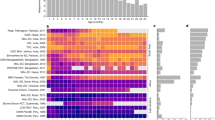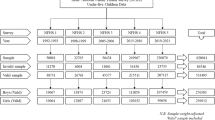Abstract
Objective:
To study whether control of malaria leads to catch-up growth or an increase of obesity in a marginally nourished population.
Setting:
A Vietnamese ethnic minority commune in southern Vietnam.
Design:
Repeated annual anthropometric surveys were performed from 1995 to 2000. Z-scores for height, weight and BMI for age and weight-for-height were determined by using NCHS 1978 and CDC 2000 reference tables and by the LMS method.
Intervention:
Active malaria control that reduced the parasite carrier rate from 50% in 1994 to practically nil in 1998.
Results:
Inhabitants were generally of short stature and very thin. Using the US reference tables, the prevalence of moderate/severe stunting among children was 53/24% and of wasting 27/9% in the first survey in 1995. Physical condition and normal daily activities of most inhabitants were normal. The repeated LMS-Z-scores uncovered a significant recovery of stunting, extending into preadolescence, including the development of a pubertal growth spurt for girls and enhancement of pubertal growth in boys, after control of malaria. The mean (95% CI) annual increase of Z-height-for-age was 0.11 (0.09–0.12) for boys and 0.14 (0.13–0.15) for girls (P<0.001). As a consequence, weight-for-age and BMI Z-scores decreased without indication of developing obesity.
Conclusion:
Catch-up growth, extending into preadolescent age, was observed in a Vietnamese ethnic minority population with a chronic state of low food intake, without indication of developing obesity. The control of malaria was probably the most significant contribution to this catch-up growth.
This is a preview of subscription content, access via your institution
Access options
Subscribe to this journal
Receive 12 print issues and online access
$259.00 per year
only $21.58 per issue
Buy this article
- Purchase on Springer Link
- Instant access to full article PDF
Prices may be subject to local taxes which are calculated during checkout




Similar content being viewed by others
References
Adair LS (1999): Filipino children exhibit catch-up growth from age 2–12 years. J. Nutr. 129, 1140–1148.
Barker DJP (1997): Maternal nutrition, fetal nutrition, and disease in later life. Nutrition 13, 807–813.
Brozek J (1966): Body composition: models and estimation equations. Am. J. Phys. Anthropol. 24, 239–246.
Cacciari E, Milani S, Balsamo A, Dammacco F, De Luca F, Chiarelli F, Pasquino AM, Tonini G & Vanelli M (2002): Italian cross-sectional growth charts for height, weight and BMI (6–20 years). Eur. J. Clin. Nutr. 56, 171–180.
Chilima DM & Ismail SJ (1998): Anthropometric characteristics of older people in rural Malawi. Eur. J. Clin. Nutr. 52, 643–649.
Chinn S, Cole TJ, Preece MA & Rona RJ (1996): Growth charts for ethnic populations in UK. Lancet 347, 839–840.
Cole TJ (1990): The LMS method for constructing normalized growth standards. Eur. J. Clin. Nutr. 44, 45–60.
Cole TJ (1994): Growth charts for both cross-sectional and longitudinal data. Statist. Med. 13, 2477–2492.
Cole TJ & Green PJ (1992): Smoothing reference centile curves: the LMS method and penalized likelihood. Statist. Med. 11, 1305–1319.
De Onis M, Monteiro C, Akre J & Glugston G (1993): The worldwide magnitude of protein-energy malnutrition: an overview from the WHO Global Database on Child Growth. Bull. World Health Organ. 71, 703–712.
De Onis M, Garza C & Habicht JP (1997): Time for a new growth reference. Pediatrics 100, E8.
De Onis M, Dasgupta P, Saha S, Sengupta D & Blossner M (2001): The National Center for Health Statistics reference and the growth of Indian adolescent boys. Am. J. Clin. Nutr. 74, 248–253.
Deurenberg P, Deurenberg-Yap M & Guricci S (2002): Asians are different from Caucasians and from each other in their body mass index/body fat per cent relationship. Obes. Rev. 3, 141–146.
Deurenberg P, Pieters JJ & Hautvast JG (1990): The assessment of the body fat percentage by skinfold thickness measurements in childhood and young adolescence. Br. J. Nutr. 63, 293–303.
Durnin JV & Womersley J (1974): Body fat assessed from total body density and its estimation from skinfold thickness: measurements on 481 men and women aged from 16–72 years. Br. J. Nutr. 32, 77–97.
Fredriks AM, van Buuren S, Wit JM & Verloove-Vanhorick SP (2000): Body index measurements in 1996–7 compared with 1980. Arch. Dis. Child. 82, 107–112.
Freeman JV, Cole TJ, Chinn S, Jones PR, White EM & Preece MA (1995): Cross sectional stature and weight reference curves for the UK, 1990. Arch. Dis. Child. 73, 17–24.
Gurrici S, Hartriyanti Y, Hautvast JG & Deurenberg P (1998): Relationship between body fat and body mass index: differences between Indonesians and Dutch Caucasians. Eur. J. Clin. Nutr. 52, 779–783.
Hop LT & Khan NC (2005): Malnutrition and poverty alleviation in Vietnam during the last period 1985–2000. Asia Pacific J. Clin. Nutr. 11, S331–S334.
Hung LQ, Vries PJ, Giao PT, Nam NV, Binh TQ, Chong MT, Quoc NT, Thanh TN, Hung LN & Kager PA (2002): Control of malaria: a successful experience from Viet Nam. Bull. World Health Organ. 80, 660–666.
Murray CJ & Lopez AD (1997): Alternative projections of mortality and disability by cause 1990–2020: global burden of disease study. Lancet 349, 1498–1504.
Ogden CL, Kuczmarski RJ, Flegal KM, Mei Z, Guo S, Wei R, Grummer-Strawn LM, Curtin LR, Roche AF & Johnson CL (2002): Centers for Disease Control and Prevention 2000 growth charts for the United States: improvements to the 1977 National Center for Health Statistics version. Pediatrics 109, 45–60.
Peeters A, Barendregt JJ, Willekens F, Mackenbach JP, Al Mamun A & Bonneux L (2003): Obesity in adulthood and its consequences for life expectancy: a life-table analysis. Ann. Intern. Med. 138, 24–32.
Pelletier DL, Frongillo Jr EA & Habicht JP (1993): Epidemiologic evidence for a potentiating effect of malnutrition on child mortality. Am. J. Public. Health. 83, 1130–1133.
Popkin BM (2001): The nutrition transition and obesity in the developing world. J. Nutr. 131, 871S–873S.
Popkin BM, Horton S, Kim S, Mahal A & Shuigao J (2001): Trends in diet, nutritional status, and diet-related noncommunicable diseases in China and India: the economic costs of the nutrition transition. Nutr. Rev. 59, 379–390.
Ramakrishnan U (2004): Nutrition and low birth weight: from research to practice. Am. J. Clin. Nutr. 79, 17–21.
Royston P & Wright EM (2000): Goodness-of-fit statistics for age-specific reference intervals. Statist. Med. 19, 2943–2962.
Tanner JM & Whitehouse RH (1975): Revised standards for triceps and subscapular skinfolds in British children. Arch. Dis. Child. 50, 142–145.
Thang NM & Popkin BM (2004): Patterns of food consumption in Vietnam: effects on socioeconomic groups during an era of economic growth. Eur. J. Clin. Nutr. 58, 145–153.
Toole MJ & Malkki RM (1992): Famine-affected refugee and displaced population: recommendations for public health issues. Morbid. Mortal. Week. Rep. 41, 1–25.
Victora CG & Barros FC (2001): Commentary: the catch-up dilemma—relevance of Leitch's ‘low-high’ pig to child growth in developing countries. Int. J. Epidemiol. 30, 217–220.
Waterlow JC (1976): Classification and definition of protein-energy malnutrition. Monogr. Ser. World Health Organ. 62, 530–555.
Waterlow JC (1984): Kwashiorkor revisited: the pathogenesis of oedema in kwashiorkor and its significance. Trans. R. Soc. Trop. Med. Hyg. 78, 436–441.
WHO expert consultation (2004): Appropriate body-mass index for Asian populations and its implications for policy and intervention strategies. Lancet 363, 157–163.
World Health Organization (1995): Physical status: the use and interpretation of anthropometry. Report of a WHO Expert Committee. Technical Report Series 854. World Health Organization World Health Organization: Geneva.
Acknowledgements
Our gratitude goes to the population of Phan Tien, who participated so selflessly throughout the study period. We thank the staff of the Binh Thuan Provincial Health Service and of Phan Tien Health-post for their help in the study. This study started as part of a research programme funded by the Dutch Ministry of Development Cooperation. There are no personal or financial relationships between the researchers and the sponsor.
Author information
Authors and Affiliations
Corresponding author
Additional information
Guarantor: LQ Hung.
Contributors: LQH, PJdV, TQB, PTG, NVN, MTC and PAK participated in the field surveys, examined the people and collected data that were entered and analysed by LQH and PJdV. LQH, PTG, TQB, NVN and MTC were responsible for continued monitoring of the studies, regular visits in between surveys, discussions and quality control. PAK, PJdV and TQB were involved in study design and writing the paper was mainly done by LQH and PJdV with contributions from PAK, TQB, PTG, NVN and MTC.
Rights and permissions
About this article
Cite this article
Hung, L., de Vries, P., Giao, P. et al. Nutritional status following malaria control in a Vietnamese ethnic minority commune. Eur J Clin Nutr 59, 891–899 (2005). https://doi.org/10.1038/sj.ejcn.1602156
Received:
Revised:
Accepted:
Published:
Issue Date:
DOI: https://doi.org/10.1038/sj.ejcn.1602156



